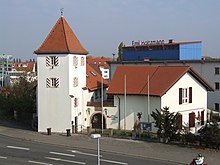Speyer Landwehr
With the Speyer Landwehr , the free imperial city of Speyer built a Landwehr as a supplement to its Speyer city wall , i.e. an advanced city fortification and delimitation of part of the city area. Waiting towers were built on the paths to the neighboring towns where they cut the wall .
Wall and waiting towers
The Landwehr consisted primarily of a wall that was made impenetrable by hedges. The wall-ditch systems with dense hedgerows were located along the boundary of the district in order to prevent the intrusion of armies, robbers and thieves or their rapid retreat. So the herds of the townspeople could be protected from cattle theft and the fields from theft and plunder.
From 1410 on, waiting towers were built from wood on the arterial roads and later from stone, which were manned by soldiers. In addition to guarding the fields and herds to the outside, a waiting room also increased the warning time when enemy troops approached.
The construction sequence was in 1410 Harthauser Holzwarte, 1410 Landauer Holzwarte, 1423 Dudenhofer Warte and below the Spitzrheinhof in 1423 the Niederwarte and 1445 the Landauer Steinwarte.
The last to be converted from a wooden structure to a stone structure was the “Wormser Warte” in 1451. A stone slab still preserved above the archway says that “Anno domini MCCCCLI (1451) is the work made (t); to the Zit were mayors. Conrad Wißhar and Claus Rinckeberg, Buwemeist. (= Master builder) Jordan and Hans Kunc ”. The fourth floor contained a guardroom. A hundred years later, the partially preserved surrounding wall was probably renewed.
The Landwehr was still being worked on in 1463.
In 1739 the council stipulated that a municipal servant, the Heimburger , “walk around or ride every quarters or happy fasting, ordering, perceiving and providing that the Landwehr chains, beatings, werren (weirs) and pitch pans in and outside the city ordered with honest people , provided and concerned ”.
Zeuss wrote in The free imperial city of Speyer before its destruction , Speyer 1843: A distance from the city were the waiting rooms, waiting towers, the Landauer Warth, Harthauser, Dudenhofer, Wormser Warth on the streets to these places.
Remnants and evidence of the Landwehr today
The " Landauer Warth " is today the namesake for the Speyerer Straße Landauer Warte .
In the former “ Wormser Warth ” - now called “ Wartturm ” - and an extension, the Association of Badisch-Palatinate Carnival Associations maintains the house of the Badisch-Palatinate Carnival . The house is the association's meeting point, museum and archive . The house, Wormser Landstrasse 265, 67346 Speyer is at the northern end of the same and marked the northernmost point of the old Speyer Landwehr. The " Landwehrstraße " begins to the west over the intersection , the southwest of which marks the former location of the Speyer Landwehr there.
See also
literature
- Karl Rudolf Müller: The walls of the free imperial city of Speyer , 1994
Individual evidence
- ↑ a b Fritz Klotz: Speyer Small City History, Speyer District Group of the Historical Association of the Palatinate, 1971, 4th exp. Edition, page 40
- ^ Fritz Klotz: Speyer Small City History, Speyer District Group of the Historical Association of the Palatinate, 1971, 4th exp. Edition, page 41
- ^ Entry waiting in the Palatinate dictionary. Founded by Ernst Christmann, continued by Julius Krämer, edited by Rudolf Post with the assistance of Josef Schwing and Sigrid Bingenheimer. 6 volumes. Franz Steiner Verlag, Wiesbaden / Stuttgart 1965–1997. © by Academy of Sciences and Literature, Mainz.
Coordinates: 49 ° 20 ′ 22.7 " N , 8 ° 25 ′ 46.5" E

